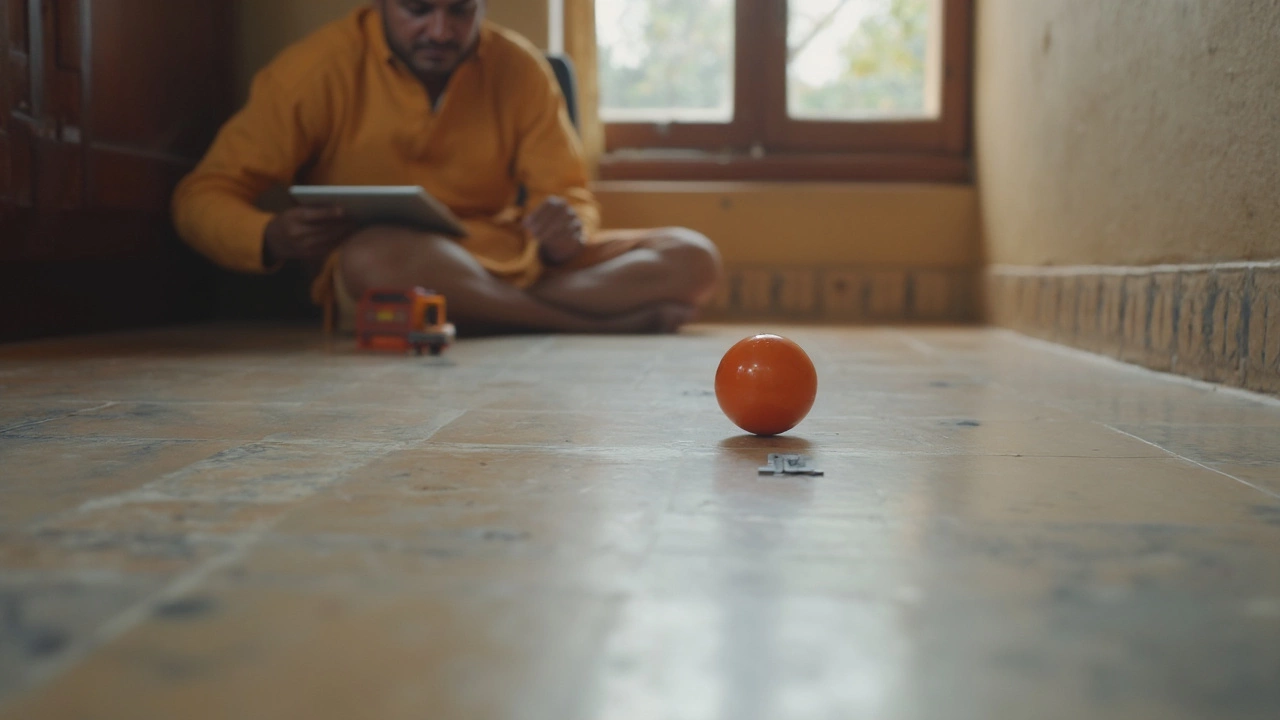One morning, you spot a thin crack zigzagging up your living room wall. Annoying? Maybe. A reason to worry? Possibly. Foundation problems sneak up in ways most folks ignore: doors that refuse to shut, sloping floors that trip you, or stubborn windows that stick for no reason. Most foundation issues start small, but if left alone, they can wreck a house and drain your wallet fast.
The first thing is to stay calm and look for clear signs. Grab a flashlight, crouch down, check for wide gaps by the baseboards, or give your floors a gentle rock—do they feel uneven? Even a bit of shifting might mean trouble under your feet. Don't just patch cracks and move on. Foundation issues don't go away on their own, and ignoring them is like skipping oil changes on your car—it always comes back to bite you.
- Spotting the Warning Signs
- Getting the Right Assessment
- Foundation Repair Options Explained
- How to Prevent Future Foundation Problems
Spotting the Warning Signs
If you’re worried your house might be shifting, don’t just look for huge cracks. Foundation trouble often starts with little things anybody can notice if they know what to look for. Ignoring that first clue can turn a minor problem into a nightmare remodel.
Here’s what you want to watch for inside the house:
- Cracks in drywall, especially around doorways and windows.
- Doors or windows that stick, won’t latch, or suddenly look crooked in their frames.
- Floors that feel sloped or bouncy—roll a marble across a suspect room and see if it veers to one side.
- Baseboards pulling away from the wall or gaps forming between walls and ceilings.
- Buckling or cracked floor tiles that keep coming back even after repair.
Outside, don’t ignore:
- Cracks in the brick or foundation itself, especially if they zigzag or are wider than a pencil.
- Brickwork, steps, or chimneys leaning away from the house.
- Any parts of the foundation that look like they’re sinking or pulling apart.
It’s not just about fancy houses, either. According to a 2023 survey by the National Association of Home Builders, nearly 25% of U.S. homes will face foundation issues at some point—especially in places with lots of clay soil or wild weather swings.
| Warning Sign | What It Might Mean |
|---|---|
| Diagonal wall crack | Possible foundation settling or shifting |
| Sticking doors | Frame has twisted from movement below |
| Sloped floor | Joists or foundation not level |
| Gap under exterior wall | Soil erosion or sinking foundation |
If you spot one of these signs, don’t panic—but don’t wait, either. Track when you first see them and note if they get worse after storms, drought, or your neighbor’s new pool. Catching problems early makes repairs far less stressful and keeps your foundation problems from getting expensive in a hurry.
Getting the Right Assessment
If you think your house has foundation problems, don't guess. Your first move should always be a thorough inspection. This isn’t something you should try to handle solo, unless you moonlight as a structural engineer. Houses settle, but not all cracks or sticking doors mean bad news. Only a pro can tell if it’s nothing to worry about—or if you’ll need serious repair work.
Start with a licensed structural engineer or a foundation repair specialist. Many foundation repair companies offer free inspections, but it's smart to pay for an independent engineer for an honest opinion. The cost for an engineer's report usually runs from $300 to $700, but that small price tag can save you thousands if it helps avoid unnecessary repairs.
- Bring out your home’s blueprints or property survey if you have them—they help an inspector spot changes in the structure.
- Have a list of what you’ve noticed (cracks, sloping, gaps, stuck doors) and when you first noticed them. Small details make a difference.
- If your neighborhood is built on clay, fill, or reclaimed land, share that. Soil type is a big deal for foundation issues.
Once the inspection is underway, the expert might use tools like a level and measuring tape to check slopes and out-of-square corners. Laser levels and moisture meters are common too. They’ll look inside and around your home to track how far any movement has gone.
Here’s a quick look at what a typical assessment involves:
| Inspection Step | Details |
|---|---|
| Check interior walls, floors, doors, and windows | Looks for misalignment, cracks, and warped frames |
| Look at exterior slab, brickwork, and siding | Finds stair-step cracks, separation, and gaps |
| Test slope of floors | Measures tilt to check if foundation has settled unevenly |
| Soil and drainage review | Assesses root cause of movement around home |
If they diagnose a foundation problem, ask to see sketches, photos, or numbers measuring how much movement there is. Good pros put everything in writing, breaking it down so you’re not left guessing. This report is your roadmap—it tells you what to fix, how soon, and what might happen if you wait.
Don’t trust a vague “you need piers everywhere” pitch. Always get a second opinion if the repair estimate is sky-high or the explanation doesn’t add up. You’d do the same if your car mechanic did the hard-sell. Same rules apply for your biggest investment—your home.

Foundation Repair Options Explained
There’s more than one way to fix a problem foundation. Some fixes are quick and cheap. Others? Not so much. The right choice depends on what’s going on under your house, the type of soil, and how bad the damage looks. Here’s a straight-up look at what’s out there and what actually gets the job done.
First off, small cracks in drywall or the plaster aren’t always a huge issue—but if cracks in your foundation problems are wider than a quarter-inch, you definitely need to consider repairs. For mild settling, epoxy injections or polyurethane foam are often used to fill and seal cracks. They keep water out but don’t do jack for movement caused by bigger problems.
- Concrete piers: Contractors drill concrete pillars deep into the ground to pick up and support the foundation. They’re solid and permanent. Costs aren’t low, but you’re looking at a solution that can last decades.
- Steel piers: Steel push piers get driven even deeper and can handle heavy homes or shifting soils. They’re a favorite for major jobs. Installers can actually lift a settled house back to where it belongs using hydraulic systems.
- Slabjacking (or mudjacking): This is common for homes with slab foundations. Experts pump a cement-like mixture underneath to raise sagging concrete. It’s quick, but only works for specific issues—if the actual soil under the home is unstable, it’s not a cure-all.
- Helical piers: These funky-looking steel screws get spun down into the ground until they hit solid soil. Helical piers are perfect when access is tight or for lighter structures like porches and additions. They’re fast and super strong.
Every approach comes with different costs, timelines, and benefits. Expect to pay anywhere from a couple thousand bucks for minor fixes up to tens of thousands for full-scale repairs. Always ask your contractor what methods they recommend and why. A real pro should be able to explain things in plain English and point out which option keeps your home safe long-term. Don’t just pick the cheapest fix—think about what the job really calls for.
How to Prevent Future Foundation Problems
If you’ve faced foundation problems once, you know how much stress (and expense) they can cause. The good news? You can avoid a ton of headaches down the road with a few simple habits and regular checkups.
Start with water. Water is hands-down the biggest enemy of your home’s foundation. Too much or too little moisture in the soil can make it shift, and it doesn’t take much shifting before problems start. Around two-thirds of all serious foundation damage comes from poor drainage, according to a 2024 survey by the Home Foundation Institute.
- Check your gutters and downspouts every spring and fall. Make sure water is flowing away from your house, not pooling near it. Extend downspouts at least 5 feet from the foundation.
- Keep the soil moisture even. In dry climates, water your foundation (yep, just like your plants) during long dry spells to keep the soil from shrinking and pulling away.
- Grade your yard so that it slopes away from your home. Experts recommend at least six inches of slope for the first 10 feet from your foundation.
- Don’t plant big trees or shrubs too close. Their roots look for water, and they can soak up all the good stuff directly under your home, leaving dry, unstable soil.
- Regularly inspect for leaks. Plumbing leaks, especially under your slab, can create major trouble. Look for wet spots, unusual bills, or cracks that suddenly appear.
A quick glance at the numbers might help drive it home:
| Prevention Step | Potential Repair Savings |
|---|---|
| Proper drainage/gutters | $5,000–$15,000 |
| Yard grading | $3,500–$8,000 |
| Plumbing leak check | $4,000–$12,000 |
One last routine that’s easy but often skipped—walk your home’s interior and exterior every few months. Look for new cracks, gaps between walls and floors, or windows and doors that start sticking again. Early action beats surprise repairs any day. If you spot something weird, don’t play the guessing game. Call a pro for an assessment before things get worse.
